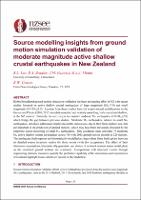Source modelling insights from ground motion simulation validation of moderate magnitude active shallow crustal earthquakes in New Zealand

Download
Date
2021-04-14Authors
Lee, Robin
Bradley, Brendon
Graves, Robert
Paterson, James
Motha, Jason
Metadata
Show full item recordAbstract
Hybrid broadband ground motion simulation validation has been an ongoing effort in NZ with recent studies focussed on active shallow crustal earthquakes of large magnitude (Mw>7.0) and small magnitude (3.5<Mw≤5.0). Lessons from these studies have led to provisional modifications to the Graves and Pitarka (2010, 2015) simulation method and velocity modelling, both crustal and shallow, in the NZ context. Naturally the next step is to consider moderate Mw earthquakes (5.0<Mw≤7.0) which bridge the gap between previous studies. Moderate Mw earthquakes, relative to small Mw earthquakes, introduce additional complexities in the simulations, due to their finite rupture size, that are important in the prediction of ground motions, which may have been previously obscured by the simplistic source modelling of small Mw earthquakes. This validation study considers 75 moderate Mw active shallow crustal earthquakes across NZ with 2042 ground motion records at 220 stations. The earthquake fault ruptures are kinematically modelled as single-plane finite faults given there are no detailed source inversion studies for these events (with few exceptions). The effect of fault dimension assumptions, kinematic slip generator, and choice of centroid moment tensor nodal plane on the simulated ground motions are examined. Comparisons with observed records through engineering intensity measures quantify the predictive capability of the simulations and examination of residuals highlight biases which are present in the prediction.
